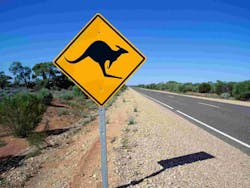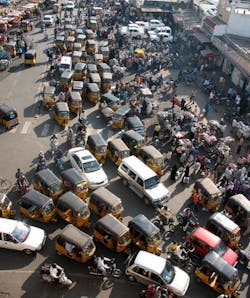As companies race to develop the next autonomous breakthrough, the obstacles that are uncovered can help measure progress.
In Australia, where the kangaroo is a national symbol, its unique characteristics are creating an unusual problem.
It turns out autonomous technology is having trouble recognizing them in mid-jump, according to Bob Pickett, certification and engineering manager at Volvo Car Australia.
While Volvo’s system successfully detects other large animals, such as moose, it believes the kangaroo is further away than it actually is while in mid-air, and closer than its actual position when it touches down.
Pickett said because cars use the pavement as a reference point, they become confused by the hop.
I did not realize at the time the true hazard they pose. There are an estimated 16,000 collisions with kangaroos a year, and insurance provider AAMI said a review of 20,000 road claims involving animals in 2015 found kangaroos accounted for 88 percent.
The kangaroo problem pales in comparison to solving the driverless vehicle puzzle in India, which has led a unit of Tata Motors to create a test track recreating the chaos of that nation’s roads.
Manufacturers and software developers are struggling with the notorious mix of massive congestion in cities, poor signage and subpar infrastructure in much of the nation.
I experienced the mayhem myself several years ago, and remain amazed my driver safely navigated the constant pedestrians and tuk-tuks darting in front of us. It was common to see cows, camels and even domesticated elephants roaming the roads, unfazed by the surroundings.
So, it comes as little surprise engineers say recognition software remains unable to identify about 15 percent of vehicles on India's roads.
Even if that seems like an almost impossible hurdle to overcome, it is worth taking a moment to acknowledge how much progress has been made in a short time.
We just crossed the three-year anniversary of Daimler AG’s unveiling of the Mercedes-Benz Future Truck 2025. The July 2014 demonstration on a closed stretch of the autobahn was a full 10 months before the Freightliner Inspiration event at the Hoover Dam.
Those events in large part helped ramp up the frenzy surrounding today’s autonomous race, at least within trucking.
It remains difficult to see the path to widespread adoption of autonomous vehicles by 2025, as had been suggested at the time. But few people, including myself, attending the 2014 event outside Berlin would have believed how much has changed in only 36 months.
About the Author
Neil Abt
Neil Abt is a former FleetOwner editor who wrote for the publication from 2017 to 2020. He was editorial director from 2018 to 2020.

